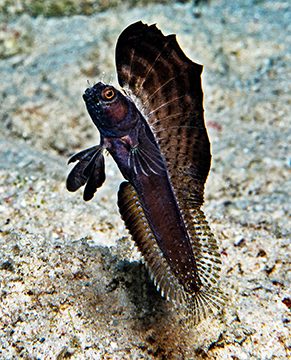DARI SEMUA IKAN DI LAUT YANG DIPUJA ANNA, blennies perch high atop her favorites list. Her fascination with the tribe of typically small, hole-inhabiting bottom-dwellers dates to the mid-1990s in the Bahamas at the kickoff of our fish-watching careers. Having a small boat, a seaside cottage, and the luxury of time, we set about investigating the complex nature of the islands’ marine life with the fervor of greenhorns.
Sweeping schools of snapper and grunts, legions of wrasses, and clouds of plankton-picking chromis greeted us on the reef each morning. But Anna’s sharp eyes, inherently attuned to the obscure, quicky discovered loveable, Muppet-faced blennies peeking out from the broken shadows of the seafloor. She was smitten.
During that first spring in Bimini, a group of volunteer divers from the recently organized Reef Environmental Education Foundation (REEF) joined us for a week to hone their fledgling fish surveying and identification skills. On the afternoon of our second day of diving the reef, an unexpected easterly storm sent us scurrying for calm water behind South Bimini’s rocky southern tip. Even though the shallow, algae-pocked inshore shallows of hardpan, rubble, and sand appeared bleak and unpromising, we decided to give it a go. With pencils and slates in hand, our group of a dozen divers tumbled off the boat and fanned out across the seemingly barren bottom as the sky darkened and rain began pelting the surface above.
Just as we feared, the few fish we could see in the dim surroundings tended to be nondescript and difficult to identify. As I considered abandoning the dive, a hand shot up, waving a yellow slate. The team converged around the hero of the moment and waited in suspense to discover what treasure she had uncovered. It wasn’t long before a dark, 2-inch silhouette powered by a thrashing tail soared above the bottom with a spectacular, oversized dorsal fin unfurled in all its glory. As if on cue, other high-flying sailfin blennies took up the cause.
Segera, dasar laut di sekitarnya berdenyut dengan jantan-jantan yang sedang kawin, menuntut perhatian dari betina-betina berwarna dasar laut yang menyelinap di antara ilusi-ilusi yang menyerupai ganggang. Ketika seekor betina merayap mendekat, pejantan-pejantan itu menjadi gila, keluar dari lubang mereka dengan sirip berkibar-kibar dalam sebuah tampilan ritualistik rayuan, memamerkan kesehatan, kekuatan, ukuran, dan kecantikan mereka. Kadang-kadang, dalam keadaan nakal, pejantan membuat garis-garis gila di bagian bawah untuk menggusur saingannya yang tinggal di dekat betina dalam pertarungan sengit dari mulut ke mulut yang mengingatkan kita pada Jurassic Park.
Setengah jam berlalu sebelum pertunjukan blenny yang tak tertahankan itu perlahan-lahan berakhir ketika koloni yang terdiri dari sekitar 30 ekor sailfish itu menghilang di dalam lubang tempat berlindung. Para surveyor, yang tercengang dengan keberuntungan mereka, dengan enggan kembali ke tugas mereka.
I hadn’t gone far when I felt a tug. It was Anna, gesturing for me to follow. She led me straight into the surge right up to the shoreline, where our bellies bumped bottom and our tanks broke the surface. Bracing herself against an oncoming wave, she pointed toward the rock-lined shore. I squinted, blinked, and stared but couldn’t see a thing until my eyes finally locked on a dark, dime-sized blenny head peering back at me with big, round, independently rotating eyes. It was a species I’d never seen. I carefully jotted down its features to help identify it from field guides later.
No sooner had I finished than Anna was waving again. Half slithering and half crawling, I arrived at her side in time to see another unfamiliar blenny dodge inside an abandoned barnacle casing. Anna’s excitement attracted others. Soon the boatload of surveyors was bumbling along the shoreline in a quest for blennies. By the time we made it back to the boat, our one-hour dive had stretched into two, the storm had passed, and the sun was setting as everyone talked at once about the best dive ever while eagerly flipping through identification books.
Later that evening, well after dinner, we were still telling and retelling tales from our epic blenny hunt. It wasn’t just the five unfamiliar blennies or novel shore fishes we encountered that made the dive so special. What we learned about the craft of fish watching on that dive has endured over the ensuing decades, beginning with a new respect for alternate habitat diving.
We also gained a real-world understanding of the term “search image.” Before Bimini, we probably swam above hundreds of sailfins, oblivious to their presence. But after spending time with sailfins, or any other cryptic species, in their natural habitat and acquiring an idea of their size, colors, and behavior, it becomes exponentially easier to find the same animal the next time around. Best of all, we discovered the joy of sharing a fascination for marine life — especially blennies — with fish-watching friends.

Segera, dasar laut di sekitarnya berdenyut dengan jantan-jantan yang sedang kawin, menuntut perhatian dari betina-betina berwarna dasar laut yang menyelinap di antara ilusi yang menyerupai ganggang.
© Penyelam Siaga — Q2 2022